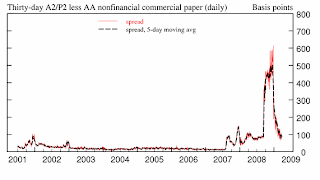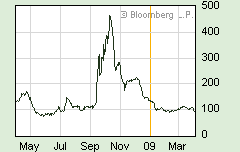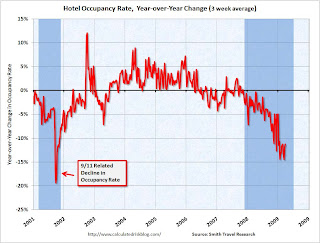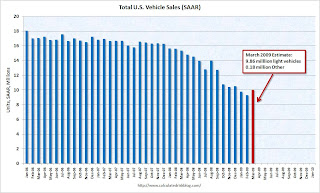by Calculated Risk on 4/02/2009 01:02:00 PM
Thursday, April 02, 2009
Credit Crisis Indicators
Here is a quick look at a few credit indicators:
First, the British Bankers' Association reported that the three-month dollar Libor rates were fixed at 1.166%. The LIBOR was at 1.30% a couple of weeks ago, and peaked at 4.81875% on Oct 10, 2008. This is near the January 14th low of 1.0825%. Click on graph for larger image in new window.
Click on graph for larger image in new window.
The first graph shows the spread between 30 year Moody's Aaa and Baa rated bonds and the 30 year treasury.
There has been some increase in the spread the last few weeks, but the spread is still below the recent peak. The spreads are still very high, even for higher rated paper, but especially for lower rated paper.
Of course the default risk has increased significantly, especially for lower rated paper. Yesterday, Moody's warned of the worst corporate default rate since at least WWII.
Corporate America's credit quality collapsed in the first quarter, with Moody's Investors Service downgrading an estimated $1.76 trillion of debt, a record high ... The downgrades included a record number to the lowest rating categories, signaling the approach of the worst defaults since at least World War Two, Moody's chief economist John Lonski said in an interview.The Moody's data is from the St. Louis Fed:
emphasis added
Moody's tries to include bonds with remaining maturities as close as possible to 30 years. Moody's drops bonds if the remaining life falls below 20 years, if the bond is susceptible to redemption, or if the rating changes.
 There has been improvement in the A2P2 spread. This has declined to 0.93. This is far below the record (for this cycle) of 5.86 after Thanksgiving, but still above the normal spread.
There has been improvement in the A2P2 spread. This has declined to 0.93. This is far below the record (for this cycle) of 5.86 after Thanksgiving, but still above the normal spread.This is the spread between high and low quality 30 day nonfinancial commercial paper.
 | Meanwhile the TED spread has decreased further over the last week, and is now at 95.3. This is the difference between the interbank rate for three month loans and the three month Treasury. The peak was 463 on Oct 10th and a normal spread is around 50 bps. |
 This graph shows the at the Merrill Lynch Corporate Master Index OAS (Option adjusted spread) for the last 2 years.
This graph shows the at the Merrill Lynch Corporate Master Index OAS (Option adjusted spread) for the last 2 years.This is a broad index of investment grade corporate debt:
The Merrill Lynch US Corporate Index tracks the performance of US dollar denominated investment grade corporate debt publicly issued in the US domestic market.The recent surge in this index was a cause for alarm, but the index appears to have stabilized - and has declined over the last week.
All of these indicators are still too high, but there has been some progress.
Hotel Occupancy: RevPAR Off 20%
by Calculated Risk on 4/02/2009 11:08:00 AM
First a quote:
"The deteriorating trends in revenue and earnings ... accelerated during the first quarter of 2009. We expect this situation to continue as long as competitors in the Las Vegas market follow a strategy of sacrificing ADR (average daily room rate) to maximize room occupancy ... " emphasis addedIt's not just in Las Vegas ...
William L. Westerman, CEO, Riviera Holdings Corp, March 31, 2009
From HotelNewsNow.com: STR reports U.S. data for week ending 28 March
In year-over-year measurements, the industry’s occupancy fell 12.3 percent to end the week at 56.6 percent (64.6 percent in the comparable week in 2008). Average daily rate dropped 8.8 percent to finish the week at US$99.77 (US$109.34 in the comparable week in 2008). Revenue per available room for the week decreased 20.0 percent to finish at US$56.50 (US$70.61 in the comparable week in 2008).
 Click on graph for larger image in new window.
Click on graph for larger image in new window.This graph shows the YoY change in the occupancy rate (3 week trailing average).
The three week average is off 11.3% from the same period in 2008.
The average daily rate is down 8.8%, so RevPAR (Revenue per available room) is off 20.0% from the same week last year.
FASB on Mark-to-Market Rules
by Calculated Risk on 4/02/2009 09:18:00 AM
From Bloomberg: FASB Eases Fair-Value Rules Amid Lawmaker Pressure (ht Mark)
... The changes approved today to fair-value, also known as mark-to-market, allow companies to use “significant” judgment in valuing assets to reduce writedowns on certain investments, including mortgage-backed securities. Accounting analysts say the measure, which can be applied to first-quarter results, may boost banks’ net income by 20 percent or more. FASB approved the changes during a meeting in Norwalk, Connecticut.Update: From Housing Wire:
If you read the headlines (and most people don’t bother to go much farther beyond the headline than the lead paragraph –- to our collective disgrace), you already think FASB eased the rules for measuring fair value on Thursday. You might believe that it has at last caved in to pressure from banks and Congress, and decided to allow “preparers” and their auditors to use judgment when valuing illiquid assets.
Not so. They are reiterating for the third time that “fair value is the price that would be received to sell the asset in an orderly transaction (that is, not a forced liquidation or distressed sale) between market participants at the measurement date.”
And for the second time it is “highlighting and expanding on the relevant principles in FAS 157 that should be considered in estimating fair value when there has been a significant decrease in market activity for the asset.”
The first time, of course, was when they issued FAS 157. The second is the SEC/FASB staff clarifications on fair value accounting issued September 30, 2008. This is the third statement, second clarification and expansion.
Monster Employment Index Declines in March
by Calculated Risk on 4/02/2009 08:44:00 AM
"The decline in U.S. online recruitment activity during March was a sober follow-up to February’s seasonal rise, as uncertainty in the future economic situation continued to keep employers on the sidelines of the hiring field.”From Monster.com: Monster Employment Index Dips Slightly in March
Jesse Harriott, senior vice president, Monster Worldwide April 2, 2009
The Monster Employment Index fell 4 points in March, and is now down 29% year-over-year, indicating a continued deceleration in online recruitment activity at the end of the first quarter.Just another indicator showing substantial weakness in the job market.
The ADP report showed private employment decreased 742,000 from February to March 2009. The weekly initial unemployment claims report showed insured unemployment is at a record 5.73 million, and initial weekly claims at a cycle high of 669 thousand.
The BLS report for March will be released tomorrow. The consensus is for a decline of 650 thousand in payroll employment ... I'll take the under.
Unemployment Insurance: More Weakness
by Calculated Risk on 4/02/2009 08:30:00 AM
The DOL reports on weekly unemployment insurance claims:
In the week ending March 28, the advance figure for seasonally adjusted initial claims was 669,000, an increase of 12,000 from the previous week's revised figure of 657,000. The 4-week moving average was 656,750, an increase of 6,500 from the previous week's revised average of 650,250.
...
The advance number for seasonally adjusted insured unemployment during the week ending March 21 was 5,728,000, an increase of 161,000 from the preceding week's revised level of 5,567,000.
 Click on graph for larger image in new window.
Click on graph for larger image in new window.This graph shows weekly claims and continued claims since 1971.
The four week moving average is at 656,750. The record was 674,250 in 1982, although that was much higher as a percent of covered employment (covered employment was 87.6 million in 1982 compared to 133.9 million today).
Continued claims are now at 5.73 million - the all time record.
Note: I'll add the normalized graph next week. This is another very weak report and shows continued weakness for employment.
LA Times on Jim the Realtor
by Calculated Risk on 4/02/2009 12:40:00 AM
From Peter Hong at the LA Times: The Hunter S. Thompson of real estate
Real estate salesman Jim Klinge ... has become a notorious Internet chronicler of the real estate crash in north San Diego County, where he has lived and worked for decades.Here is one of my favorites - Jim the Realtor showcases an investment opportunity in San Diego - enjoy!
Rather than downplay the greed and excess that caused the region's travails, he revels in exposing them.
He surveys the wreckage with a pocket video camera, shooting footage of vacant, once-pricey houses turned into eyesores, voiced over with his deadpan narration. Then he posts them on his website, at www.bubbleinfo.com.
They're shaky, noisy clips full of coarse images and language.
More from the LA Times:
In one clip, the camera pans across the kitchen of a million-dollar fixer near Interstate 5. He pointedly notes the house's proximity to the freeway, which he calls the "De-troit river." There's mold under the sink and a foot-sized hole in the drywall just above the floor.I really enjoy Jim's videos ... Here is a compilation video Jim posted today:
"December 2006 this house sold for a million dollars," he says. "Nineteen hundred square feet, built in '78, right across the freeway. One million."
...
His wife, Donna, who helps manage the family brokerage, was nervous. "He was really pushing the envelope with the blog, taking people on, naming names," she said. "I took deep breaths. I didn't know how it would turn out."
She said she was shocked one day to see a photo on the blog of two young men sitting on the floor of a house with their wrists bound like prisoners. They had been squatting in a foreclosed house Jim was selling, and he had sneaked up on them as they slept and tied them up with plastic zip ties in a brazen citizen’s arrest.
Wednesday, April 01, 2009
NPR: Anatomy Of A Bank Takeover
by Calculated Risk on 4/01/2009 10:59:00 PM
From NPR (with Chicago Public Radio: This American Life), here is a story about the FDIC takeover of Bank of Clark County: Anatomy Of A Bank Takeover (ht Ted)
Here is the audio from NPR.
Here is the FDIC announcement from January: Umpqua Bank Acquires the Insured Deposits of Bank of Clark County, Vancouver, WA
 | At least they get free ice cream! Click on photo for larger image in new window. Photo Credit: Otishertz, January 2009 |
Auto Sales: Ray of Sunshine?
by Calculated Risk on 4/01/2009 08:25:00 PM
In Looking for the Sun, I suggested there might be three areas to look for "rays of sunshine in a very dark season": housing starts, new home sales, and auto sales.
Just like for housing starts and new home sales, it is way too early to call a bottom for auto sales - but it does look like vehicle sales increased in March on a seasonally adjusted annual rate (SAAR) basis. Click on graph for larger image in new window.
Click on graph for larger image in new window.
This graph shows the historical vehicle sales from the BEA (blue) and an estimate for March (light vehicle sales of 9.86 million SAAR from AutoData Corp).
Note: this graph includes a small number of heavy vehicle sales to compare to the BEA.
From the WSJ: Auto Makers See a Ray of Hope
The annualized sales pace ... came in at 9.86 million vehicles, well below the 16 million or more the industry typically logged a few years ago, but up from February's pace of 9.12 million.Even if this is the bottom for auto sales (way too early to call), the pickup will probably be very sluggish - especially considering the grim unemployment news and continuing financial crisis.
"I believe we are in a bottoming process for the industry," Bob Carter, a group vice president at Toyota Motor Corp., said in a conference call. ...
Michael DiGiovanni, the top sales analyst at General Motors Corp., said he expects a "very, very gradual pickup" in vehicle sales in the second quarter. He cited "the first signs of brightening" in the market. ...
Moody's Warns of Worst Corporate Default Rate since WWII
by Calculated Risk on 4/01/2009 06:09:00 PM
From Reuters: Moody's downgraded $1.76 trln U.S. corp debt in Q1
... Moody's Investors Service downgrading an estimated $1.76 trillion of debt, a record high ...Hopefully the bank stress tests have all these defaults factored in ...
The downgrades included a record number to the lowest rating categories, signaling the approach of the worst defaults since at least World War Two ...
"The most prominent new driving force behind credit rating reductions would be deterioration of commercial real estate," [Moody's chief economist John Lonski] said. ...
Moody's has forecast that the U.S. default rate will peak around 14.5 percent in November.
emphasis added
Moody's: Record High Credit Card Charge-Offs
by Calculated Risk on 4/01/2009 05:57:00 PM
From Reuters: Credit card charge-offs hit record high -Moody's (ht Brad)
Credit card write-downs soared to record levels in February, representing an all-time high in the 20-year history of the Moody's Credit Card Index ....Moody's reported the charge-off rate at 5.59% in February 2008, and 4.51% in February 2007.
Credit card charge-offs, the write-down of uncollectable debt, advanced decisively to 8.82 percent in February, marking the sixth consecutive month of increases. The level, is more than 300 basis points higher than a year ago.
...
[Moody's] predicts the charge-off rate index will peak at about 10.5 percent in the first half of 2010, assuming a coincident unemployment rate peak at 10 percent.


